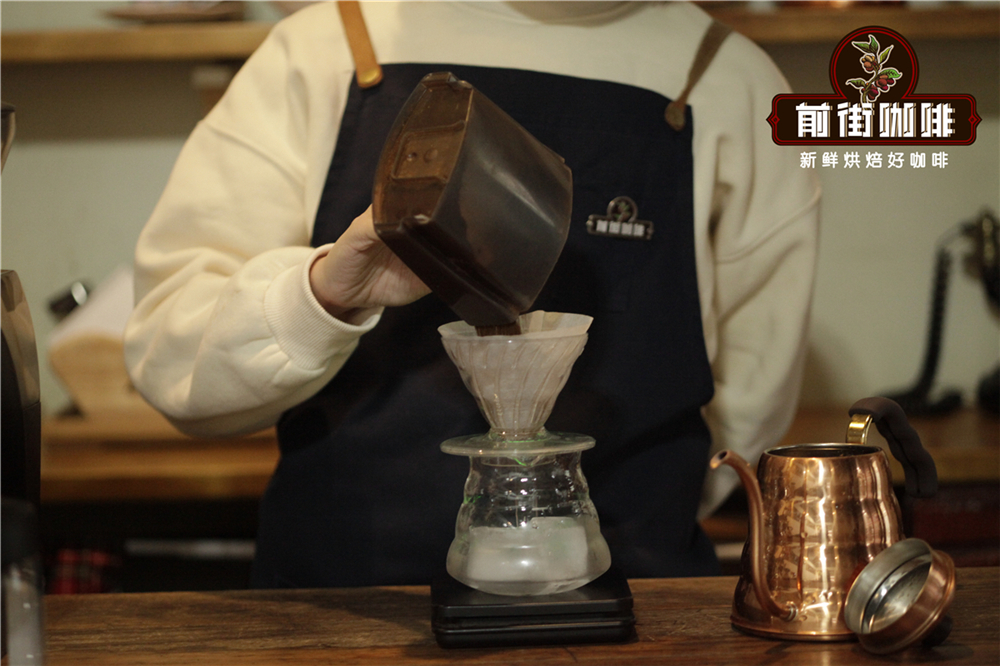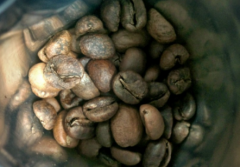A detailed description of the parameters of Japanese-style iced hand-made coffee first or later
Guide reading
A few days ago, a guest asked, "how do your ice hands make coffee? is there any difference between adding ice first and adding ice later?" In this issue, Qianjie will do an experiment to compare it, hoping to give you a reference.

Sharing parameters of ice hand brewing coffee in Qianjie
Qianjie ice hand coffee brewing uses 15 grams of coffee powder, the powder-to-water ratio is 1:10, that is, 15 grams of coffee powder brewing 150g of hot water, plus 100g ice cooling dilution (as for adding ice first or then adding ice is a part of this article).

The grinding degree of the coffee powder will also be finer than the hot hand brewing. For the Ethiopian Arsi coffee brewing experiment, the front street hot hand brewing scale is BG-5H (the standard sieve 20 passes 80%), and the ice hand brewing scale is reduced to a large BG-4H (85% standard sieve 20). In terms of water temperature, 90-91 ℃ is used for light roasting coffee and 87-89 ℃ for medium and deep roasting coffee.

Experimental comparison
First put the ice: first put 100 grams of ice on the sharing pot, put the filter cup and filter paper up, then put 15 grams of ground coffee powder, and the electronic scale returns to zero.

First of all, 30 grams of hot water is injected into the first stage for steaming for 30 seconds, and then 70 grams of hot water is injected around the center. As the coffee powder is ground slightly, the powder layer is raised at once, and the launching speed is slower than that of hot hands. When the water level drops to 1 stroke 2, continue to inject 50 grams of water, wait for the coffee liquid to flow into the pot, remove the filter cup, and the extraction time is 1 minute and 40 seconds. Then shake the filter cup around to make the coffee liquid cool quickly and evenly.

After putting ice: after the preparation stage is over, pour in 15 grams of coffee powder and begin to inject water. in the first stage, 30 grams of hot water is injected into the pot for 30 seconds, then 70 grams of hot water is injected outward in the center, and then 50 grams of water is injected into 2 places when the water level drops to 1 stroke. After all the coffee liquid flows into the pot, remove the filter cup, the extraction time is 1 minute 40 seconds. Then add 100 grams of ice to the pot and shake the filter cup to make the coffee liquid cool quickly and evenly.


Sensory contrast
In the horizontal repeated taste and comparison, in the case of uniform swing, the two methods are generally consistent, in the first attempt, the first iced coffee will appear cleaner, refreshing, the aroma is a hint of flower and fruit aroma. Then the aroma of ice will be concentrated and more varied when tasting. Of course, the iced coffee made by these two methods is still very close, if there is no horizontal comparison, it may not be able to tell.

As for why it is more refreshing to put the ice first, when we compare the two states at the end of the first swing, the ice that is released first obviously melts more than the ice that is released later, because releasing ice first is a continuous cooling process, in which the temperature of the initial coffee liquid will be higher and more ice will be dissolved. After cooking and adding ice, it is "cooled" at room temperature and then cooled by ice, so less ice will be dissolved.

Seeing this result, I believe everyone will no longer put ice first or later.
Important Notice :
前街咖啡 FrontStreet Coffee has moved to new addredd:
FrontStreet Coffee Address: 315,Donghua East Road,GuangZhou
Tel:020 38364473
- Prev

Coffee treatment | what is Simon's special treatment? Essegugu Adora coffee bean watermelon flavor
In the current wave of post-treatment, there are more and more coffee beans with special treatment, and the classification between treatments is becoming more and more detailed. And Simon's special treatment introduced today is also a very interesting treatment. Let's first take a look at the appearance of coffee beans. When you see such coffee beans, you may think that they are defective beans, uneven in color and ugly in appearance.
- Next
How does the caking of coffee powder affect the effect of humidity on coffee extraction? is the coffee powder coarse or fine in rainy days?
With the continuous drizzle in recent days, Guangzhou has officially ushered in spring. Recently, there is a small partner private channel, how to adjust the Italian production in rainy days? So this issue of baristas will tell you how to deal with Qianjie, hoping to help you. What will be the effect of rainy days? Some friends who do not understand but think this is very powerful may think that sunny and rainy days are not very common, so why should they?
Related
- Beginners will see the "Coffee pull flower" guide!
- What is the difference between ice blog purified milk and ordinary milk coffee?
- Why is the Philippines the largest producer of crops in Liberia?
- For coffee extraction, should the fine powder be retained?
- How does extracted espresso fill pressed powder? How much strength does it take to press the powder?
- How to make jasmine cold extract coffee? Is the jasmine + latte good?
- Will this little toy really make the coffee taste better? How does Lily Drip affect coffee extraction?
- Will the action of slapping the filter cup also affect coffee extraction?
- What's the difference between powder-to-water ratio and powder-to-liquid ratio?
- What is the Ethiopian local species? What does it have to do with Heirloom native species?

